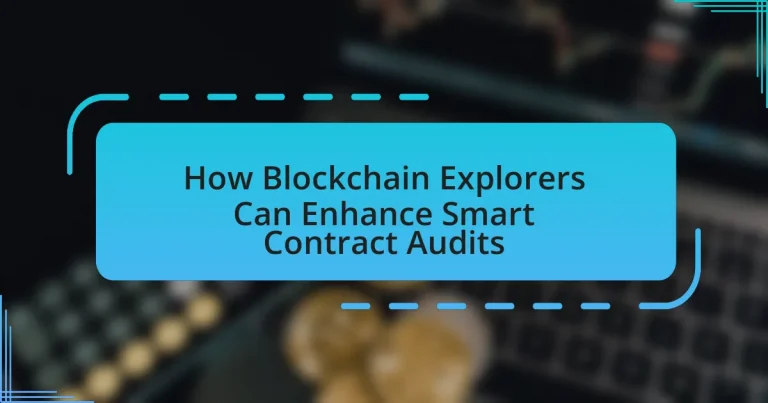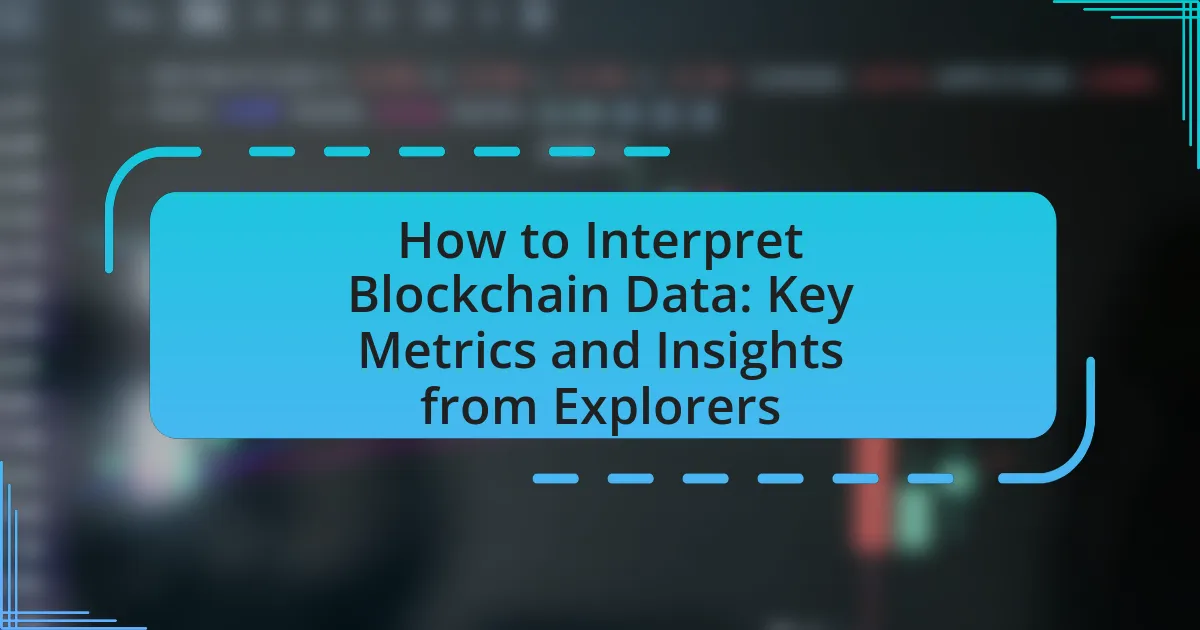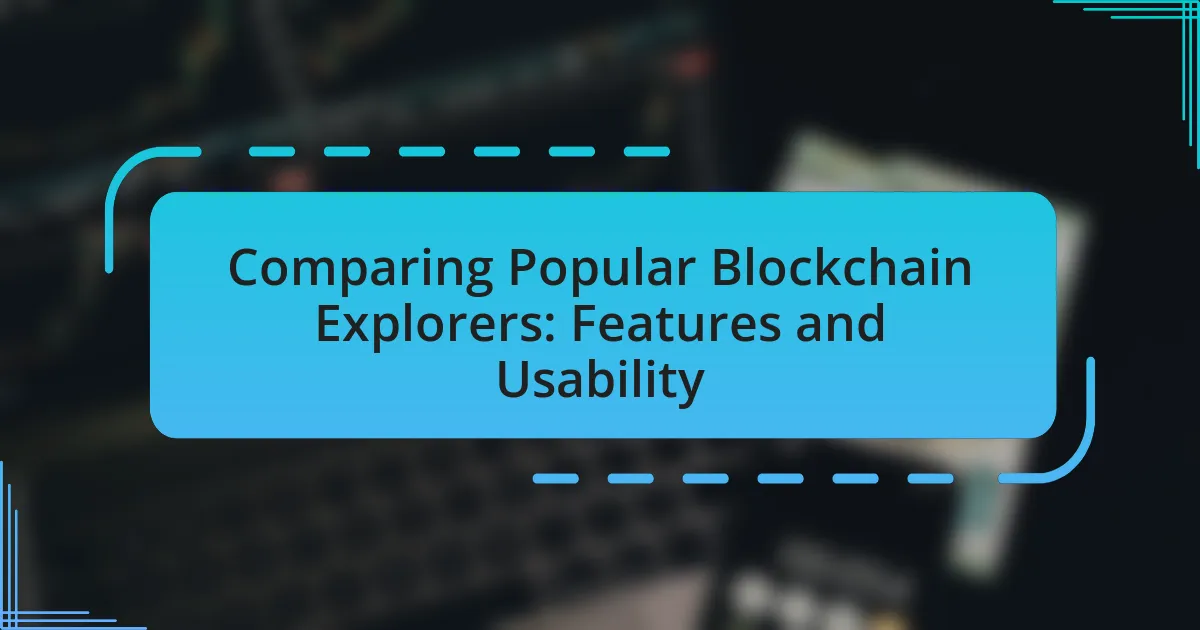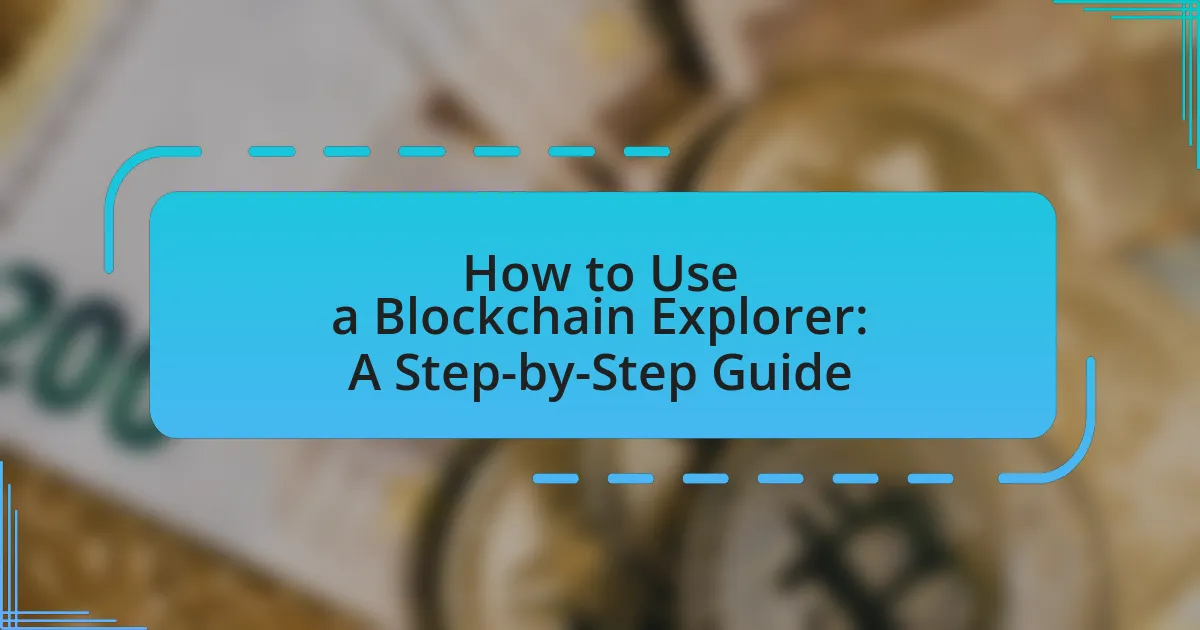Blockchain explorers are essential tools that enhance the auditing process of smart contracts by providing transparent access to transaction data and contract interactions on the blockchain. They enable auditors to verify the execution of smart contracts in real-time, trace the flow of funds, and identify potential vulnerabilities. The article discusses the functionality of blockchain explorers, their role in ensuring transparency and accountability, and the importance of smart contract audits in preventing financial losses. Additionally, it highlights the challenges auditors face when using these explorers and outlines best practices for effectively interpreting the data they provide.
How can blockchain explorers enhance smart contract audits?
Blockchain explorers enhance smart contract audits by providing transparent access to transaction data and contract interactions on the blockchain. This transparency allows auditors to verify the execution of smart contracts in real-time, ensuring that the code behaves as intended and that there are no discrepancies between the code and its execution. For instance, blockchain explorers can display transaction histories, enabling auditors to trace the flow of funds and confirm that all operations align with the smart contract’s specifications. Additionally, the ability to analyze on-chain data helps identify potential vulnerabilities or irregularities, thereby improving the overall security and reliability of smart contracts.
What are blockchain explorers and their role in the blockchain ecosystem?
Blockchain explorers are web-based tools that allow users to view and interact with the data stored on a blockchain. They play a crucial role in the blockchain ecosystem by providing transparency, enabling users to track transactions, view block details, and analyze network activity. For instance, explorers like Etherscan for Ethereum and Blockchair for Bitcoin allow users to search for specific transactions, addresses, and blocks, thereby enhancing accountability and trust in the system. This transparency is essential for smart contract audits, as it allows auditors to verify the execution and integrity of contracts by examining the transaction history and interactions on the blockchain.
How do blockchain explorers function in tracking transactions?
Blockchain explorers function by providing a user-friendly interface to access and analyze transaction data recorded on a blockchain. They allow users to input transaction IDs, wallet addresses, or block numbers to retrieve detailed information about specific transactions, including timestamps, amounts, and the status of the transaction. This functionality is essential for transparency and accountability in blockchain networks, as it enables users to verify transactions independently. For example, Bitcoin blockchain explorers like Blockchair and Blockchain.com display real-time data on transactions, blocks, and addresses, facilitating the tracking of funds and ensuring that all transactions are publicly accessible and immutable.
What features do blockchain explorers provide for users?
Blockchain explorers provide users with features such as transaction tracking, block information retrieval, and wallet address monitoring. These tools allow users to view real-time data about transactions, including details like transaction IDs, timestamps, and confirmation statuses. Additionally, explorers enable users to access information about specific blocks, including block height, miner details, and the number of transactions within each block. Users can also monitor wallet addresses to see their transaction history and current balances, enhancing transparency and accountability in blockchain networks.
Why are smart contract audits important?
Smart contract audits are important because they identify vulnerabilities and ensure the security and functionality of the code before deployment. These audits help prevent costly exploits and failures, as evidenced by the fact that over $1.3 billion was lost to smart contract hacks in 2021 alone. By conducting thorough audits, developers can enhance trust among users and stakeholders, ultimately contributing to the overall integrity of blockchain ecosystems.
What risks are associated with unverified smart contracts?
Unverified smart contracts pose significant risks, including vulnerabilities to exploits, lack of accountability, and potential financial loss. These contracts may contain coding errors or security flaws that malicious actors can exploit, leading to unauthorized access or fund theft. Additionally, without verification, there is no assurance of the contract’s functionality or adherence to intended specifications, increasing the likelihood of operational failures. The absence of a trusted audit process means that users cannot hold developers accountable for any issues that arise, further compounding the risk of financial loss and damage to reputation.
How do audits contribute to the security of smart contracts?
Audits enhance the security of smart contracts by systematically identifying vulnerabilities and ensuring compliance with best practices. Through thorough code review and testing, audits reveal potential flaws that could be exploited, thereby mitigating risks before deployment. For instance, a study by ConsenSys found that 70% of smart contracts contain vulnerabilities, highlighting the critical role of audits in safeguarding against attacks. By addressing these issues, audits not only improve the reliability of smart contracts but also foster trust among users and stakeholders in the blockchain ecosystem.
What specific ways do blockchain explorers improve smart contract audits?
Blockchain explorers improve smart contract audits by providing transparent access to transaction histories, enabling real-time monitoring of contract interactions, and facilitating the verification of contract code against on-chain activity. They allow auditors to trace the flow of funds and interactions, ensuring that the smart contract behaves as intended. For instance, explorers like Etherscan display detailed transaction logs, which help auditors identify anomalies or unexpected behaviors in contract execution. This level of transparency and traceability is crucial for validating the integrity and security of smart contracts, ultimately enhancing the overall audit process.
How can transaction history analysis aid in auditing smart contracts?
Transaction history analysis aids in auditing smart contracts by providing a detailed record of all interactions and transactions associated with the contract. This analysis allows auditors to trace the flow of funds, verify the execution of contract functions, and identify any anomalies or irregularities in transaction patterns. For instance, by examining transaction timestamps, amounts, and addresses involved, auditors can detect unauthorized access or potential exploits. Furthermore, historical data can reveal trends and behaviors that indicate whether the smart contract is functioning as intended, thereby enhancing the overall security and reliability of the contract.
What insights can blockchain explorers provide regarding contract interactions?
Blockchain explorers provide detailed insights into contract interactions by allowing users to track transaction histories, view contract states, and analyze gas fees associated with contract executions. These tools enable users to monitor real-time data on how contracts are being utilized, including the frequency of interactions and the specific functions being called. For instance, explorers can display the number of transactions sent to a contract, the addresses involved, and the timestamps of these interactions, which helps in assessing the contract’s activity and performance. This data is crucial for audits, as it allows auditors to identify patterns, detect anomalies, and ensure that the contract behaves as intended.
How do blockchain explorers facilitate transparency in smart contract audits?
Blockchain explorers facilitate transparency in smart contract audits by providing real-time access to transaction data and contract interactions on the blockchain. These tools allow auditors and users to verify the execution of smart contracts, track transaction histories, and analyze contract code directly on the blockchain. For instance, explorers display detailed information such as transaction timestamps, gas fees, and the addresses involved, enabling a comprehensive review of contract behavior. This transparency is crucial for identifying vulnerabilities and ensuring compliance with intended functionalities, as evidenced by the ability to trace all interactions with a smart contract back to its origin, thereby enhancing trust and accountability in the auditing process.
What role does public access to data play in enhancing audit processes?
Public access to data significantly enhances audit processes by increasing transparency and accountability. When data is publicly accessible, auditors can independently verify transactions and operations, reducing the risk of fraud and errors. For instance, blockchain technology allows for real-time access to transaction records, enabling auditors to conduct more thorough and efficient audits. This transparency fosters trust among stakeholders, as they can see the same data that auditors are reviewing, thereby reinforcing the integrity of the audit process.
How can explorers help in identifying fraudulent activities related to smart contracts?
Explorers can help identify fraudulent activities related to smart contracts by providing transparent access to transaction data and contract interactions on the blockchain. They allow users to trace the flow of funds, monitor contract execution, and analyze transaction patterns, which can reveal anomalies indicative of fraud. For instance, explorers can highlight unusual transaction volumes or frequencies that deviate from typical behavior, signaling potential scams or exploits. Additionally, explorers often include features that enable users to view contract code and its history, facilitating the detection of malicious modifications or unauthorized changes. This level of transparency and analysis is crucial for maintaining trust and security in decentralized applications.
What challenges do auditors face when using blockchain explorers?
Auditors face several challenges when using blockchain explorers, primarily related to data interpretation and the complexity of blockchain technology. The decentralized and pseudonymous nature of blockchain can make it difficult for auditors to trace transactions back to specific entities, complicating the verification process. Additionally, the sheer volume of data available on blockchain explorers can overwhelm auditors, making it challenging to identify relevant transactions or anomalies. Furthermore, the lack of standardized reporting formats across different blockchain platforms can hinder the consistency and comparability of audit findings. These challenges necessitate specialized knowledge and tools to effectively utilize blockchain explorers in audits.
How can data overload from explorers complicate the audit process?
Data overload from explorers complicates the audit process by overwhelming auditors with excessive information, making it difficult to identify relevant data. This influx of data can lead to inefficiencies, as auditors may struggle to sift through large volumes of transactions and smart contract interactions, potentially missing critical anomalies or errors. For instance, blockchain explorers can generate extensive logs of transactions, which, if not properly filtered, can obscure significant patterns or issues that require attention during the audit.
What limitations exist in the data provided by blockchain explorers?
Blockchain explorers have limitations in data accuracy, completeness, and interpretability. The data may not reflect real-time transactions due to network latency, leading to outdated information. Additionally, blockchain explorers often lack contextual details about transactions, such as the purpose or intent behind them, making it difficult to assess their significance. Furthermore, the pseudonymous nature of blockchain transactions can hinder the identification of parties involved, complicating audits and analyses. These limitations can affect the reliability of insights drawn from blockchain explorers, particularly in the context of smart contract audits, where precise and comprehensive data is crucial for effective evaluation.
What best practices should auditors follow when utilizing blockchain explorers?
Auditors should follow best practices such as verifying transaction authenticity, ensuring data integrity, and maintaining a comprehensive audit trail when utilizing blockchain explorers. Verifying transaction authenticity involves cross-referencing blockchain data with external records to confirm accuracy. Ensuring data integrity requires auditors to assess the reliability of the blockchain explorer being used, as different explorers may present varying levels of data accuracy. Maintaining a comprehensive audit trail is essential for tracking changes and transactions over time, which can be achieved by documenting all findings and methodologies used during the audit process. These practices enhance the effectiveness of audits by providing a clear, verifiable, and accurate assessment of smart contracts on the blockchain.
How can auditors effectively interpret data from blockchain explorers?
Auditors can effectively interpret data from blockchain explorers by utilizing analytical tools and techniques to analyze transaction histories, wallet addresses, and smart contract interactions. These explorers provide real-time access to blockchain data, allowing auditors to trace transactions, verify balances, and assess the flow of funds. For instance, auditors can identify patterns of behavior, such as unusual transaction volumes or frequent transfers between specific addresses, which may indicate potential fraud or compliance issues. Additionally, blockchain explorers often include features like filtering and searching capabilities, enabling auditors to focus on specific contracts or addresses relevant to their audit. This methodical approach ensures that auditors can derive actionable insights from the data presented, enhancing the overall integrity and transparency of smart contract audits.
What tools can complement blockchain explorers in smart contract audits?
Tools that can complement blockchain explorers in smart contract audits include static analysis tools, formal verification tools, and testing frameworks. Static analysis tools, such as Mythril and Slither, analyze smart contract code for vulnerabilities without executing it, identifying potential security issues early in the development process. Formal verification tools, like Certora and K Framework, mathematically prove the correctness of smart contracts against specified properties, ensuring that the code behaves as intended. Testing frameworks, such as Truffle and Hardhat, facilitate the creation and execution of test cases to validate smart contract functionality and performance. These tools enhance the auditing process by providing comprehensive analysis and verification capabilities beyond what blockchain explorers offer.





